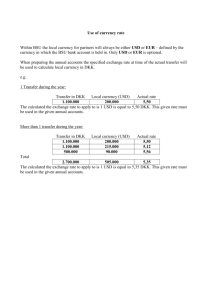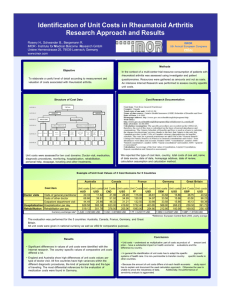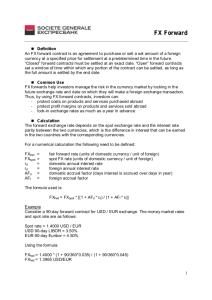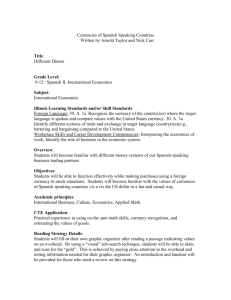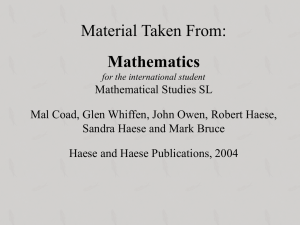Hedging with Foreign Currency Options
advertisement
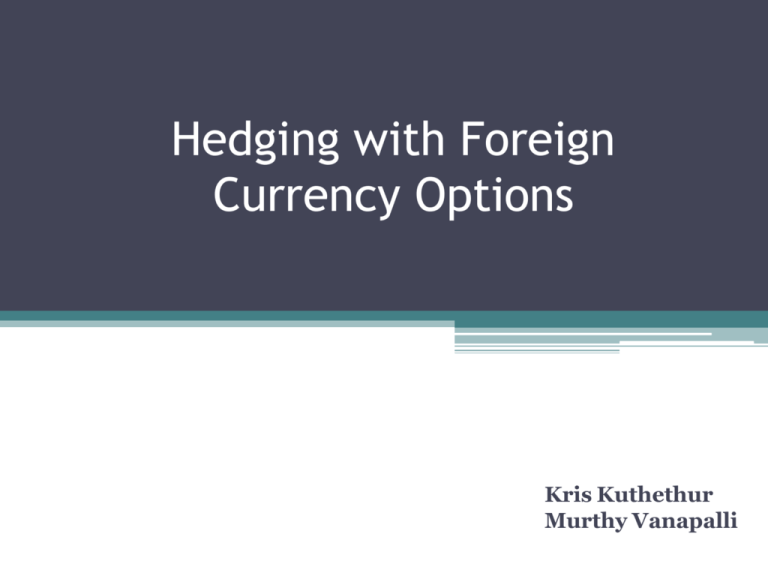
Hedging with Foreign Currency Options Kris Kuthethur Murthy Vanapalli Foreign Currency Option • Financial instrument that gives the holder the right, but not the obligation, to sell or buy currencies at a set price called the “strike price” or “exercise price” before a specified maturity date. • American Option • European Option • Bermudan Option Why and When to use Options? • Can be used to hedge potential transactions, or transactions that are contingent on something • Can be used when we are uncertain about exchange rates in the future. • May be useful whenever a firm wants to protect itself from the downside risk of exposure but reap some of the benefits on the upside Call and Put Options • Call ▫ Long position ▫ Option contains the right but not the obligation to “buy” currency at the exercise price ▫ Used to hedge foreign currency-outflows (payables) • Put ▫ Short position ▫ Option contains the right but not the obligation to “sell” currency at the exercise price ▫ Used to hedge foreign currency-inflows (receivables) Options Concept BUY the Option PAY PREMIUM SELL the Option RECEIVE PREMIUM Call Option on the Dollar Put Option on the Yen Obtain the RIGHT to buy the dollars and to sell the yen. Risk is to a positive move in dollars. Assume the OBLIGATION to sell the dollars and to buy the yen. Risk is to a negative move in dollars. Put Option on the Dollar Call Option on the Yen Obtain the RIGHT to sell the dollars and to buy the yen. Risk is to a negative move in dollars. Assume the OBLIGATION to buy the dollars and to sell the yen. Risk is to a positive move in dollars. Concepts Protection till maturity is a positive factor. However, there is a cost now, which is a negative factor. Reward now is a positive factor. However, there are risks till maturity, which is a negative factor. Comparison of Hedging Alternatives Currency Option Foreign Exchange Forwards Right but not obligation to buy/sell options Obligation to buy/sell currency Premium payable No premium payable Wide range of strike prices Only one forward rate for a particular date Retains unlimited profit potential while limiting downside risk Eliminates the upside potential as well as the downside risk Flexible delivery date of currency Fixed delivery date of currency Review of Hedging Techniques Hedging Technique To Hedge Payables To Hedge Receivables Forward/Futures hedge Buy a currency futures/forward contract representing the currency and amount related to the payables. Sell a currency futures/forward contract representing the currency and amount related to the receivables. Money market hedge Borrow home currency and convert to currency denominating payables. Invest these funds until they are needed to cover the payables. Borrow currency denominating receivables and convert to home currency. Invest these funds. The foreign loan is paid with the receivables. Currency option hedge Purchase a currency call option representing the currency and amount related to the payables. Purchase a currency put option representing the currency and amount related to the receivables. Hedging Foreign Currency Outflows • To protect against Pound appreciation, a firm has decided to purchase a £500,000 call option on British Pounds. The strike price written into the option is $1.55/£ and the premium is 3 cents per pound. • Premium = $0.03 X 500,000 = $15,000 • Ceiling price = 1.55 + 0.03 = $1.58/£ Profit profile of Call Option Profit + 0 1.55 1.58 0.03 - $/foreign currency Hedging Foreign Currency Inflows • A US company may have a cash inflow of 125,000 DM within the next quarter and decides to hedge this potential inflow using put options. The current spot rate is $0.60/DM and the company purchases options with a strike price of $0.56/DM for 0.5 cents per DM • Premium = $0.05 X 125,000 = $6,250 • Floor price = 0.56 – 0.5 = $0.51/DM Profit profile of Put Option Profit + 0.56 0 0.51 0.05 - $/foreign currency Hedging in an M & A scenario • On Feb 1st, Sundance Corp., a U.S. firm, agrees to buy Cogna Cola Inc., an Australian beverage manufacturer for AUD 100 million. The deal is set to close in late June (in five months) if it passes the vote of the Board of Directors of Cogna Cola Inc. The deal is priced in AUD, but Sundance’s books and financing are in USD. The company is prepared for some variability in the USD cost of the deal, but has an internal break-even point beyond which the acquisition becomes Therefore, Sundance faces a currency risk!! unattractive. Hedging in an M & A scenario … Contd • Sundance can easily hedge the currency risk by buying AUD forward. Today is February 1, 1999. The spot rate is 0.6721 USD/AUD; the June futures rate is 0.6772 USD/AUD. It would cost Sundance USD 67.72 million to buy AUD 100 million forward at the June futures rate. This would be a perfect hedge if the future were certain! Hedging in an M & A scenario … Contd • But what if the deal fails because of opposition of the Cogna Cola's Board of Directors and falls through? Sundance would have to buy AUD anyway and then convert them back to USD. If the USD strengthened in the interim to below 0.6772 USD/AUD, Sundance would lose money in the conversion. The stronger the USD, the greater the loss. If the USD/AUD were at 0.6050 USD/AUD, for instance, Sundance would spend USD 67.72 million buying AUD at USD 0.6772, but receive only USD 60.50 million reconverting the AUD to USD. Hedging in an M & A scenario … Contd • Sundance faces two risks: changes in exchange rates and the uncertainty of the deal's closure. • Clearly, buying dollars forward covers one, but exacerbates the other. • Sundance can choose ▫ At-the-money Option ▫ Zero-premium Collar Hedging in an M & A scenario … Contd • At-the-money Option ▫ Buy: June 0.6700 USD/AUD American Call for AUD 100 million (2,000 contracts) ▫ Total Cost: USD 2,172,025 Premium USD 0.0217 per AUD = USD 2,170,000 Broker fee USD 25 + USD 1.00 per contract = USD 2,025 ▫ If the deal goes through, Sundance buys AUD at USD 0.6700. If it fails and the AUD has appreciated to, say, USD 0.6900, it may still exercise the option and make a profit of USD 2 million ▫ If the deal fails and the AUD has depreciated, the call option is not exercised. The strategy's major drawback is its cost. Hedging in an M & A scenario … Contd • Zero-premium Collar ▫ Buy: June 0.7000 USD/AUD American Call for AUD 100 million (2,000 contracts). ▫ Sell: June 0.6600 USD/AUD American Put for AUD 100 million (2,000 contracts) with a Put Knock-in 0.6450 USD/AUD. ▫ Total Cost: USD 4,050 Premium paid: USD 0.009 per AUD call = USD 900,000 Premium received: USD .009 per AUD put = USD 900,000 Broker fee USD 25 + USD 1.00 per contract = USD 4,050 ▫ If the deal goes through, Sundance knows it will pay no more than USD 70 million for Cogna Cola Inc. The strategy is relatively inexpensive, but its potential cost is that Sundance may have to cover its short position in USD if the USD appreciates against the mark below 0.6600 USD/AUD. ▫ The wrinkle here is that the AUD put is triggered only if the AUD depreciates below USD 0.6450, a large decrease that would be unlikely to occur in the next five months. DISCRETE & CONTINUOUS TIME OPTION PRICING EXAMPLES Formulae: Binomial Option Pricing S S .u S S .u S .u.u S .u 2 S S .d Stock price in the up state S Current stock price S Stock price in the down state S C M ax[S X , 0] Want to find the current option price C C M ax[S X , 0] Option payoff in the up state Option payoff in the down state Two Period Binomial Model S , C S , C π is called “risk-neutral probability” S .d S .d .d S .d S S C C C C Max (0, S C C Max (0, S X ) Max (0, S X) Max (0, S X ) C X) Max (0, S (1 )C 1 r C (1 )C C 1 r 1 r d ud C (1 )C C 1 r C C n S S C C n S S C C n S S …and so on 2 S .u.d S .d .u S , C S , C C S , C S , C (?) S X) Example – Two Period Binomial Model – Put Option Pricing – Discrete Time Consider a two-period binomial model in which the underlying is at 30 and can go up 14 percent or down 11 percent each period. The risk-free rate is 3 percent per period. A. Find the value of a European call option expiring in two periods with an exercise price of 30. B. Find the number of units of the underlying that would be required at each point in the binomial tree to construct a risk-free hedge using 10,000 calls. Solution: Given: X = 30 u = 1 + 0.14 = 1.14 d = 1 – 0.11 = 0.89 r = 0.03 Calculations Conclusions S+ = 30(1.14) = 34.20 S++ = 30(1.14)(1.14) =38.99 S- = 30(0.89) = 26.70 S-- = 30(0.89)(0.89) = 23.76 S+- = S-+= Sud = 30(1.14)(0.89) = 30.44 C++ = Max(0, 38.99 – 30) = 8.99 C+- = Max(0, 30.44 – 30) = 0.44 The number of units of the underlying required for 10,000 calls would thus be 6,453 today, 10,000 at time 1 if the underlying is at 34.20 and 659 at time 1 if the underlying is at 26.70 At price of 30 and time 0, the risk free hedge would consist of a short position in 10,000 calls and a long position in 6,453 shares of the underlying. C-- = Max(0, 27.36 – 30) = 0 π = (1 + 0.03 – 0.89) / (1.14 – 0.89) = 0.56; 1 -π = 1 – 0.56 = 0.44 C+ = [0.56(8.99) + 0.44(0.44)] / [1 + 0.03] = 5.08 C- = [0.56(0.44) + 0.44(0.0)] / [1 + 0.03] = 0.24 C = [0.56(5.08) + 0.44(0.24)] / [1 + 0.03] = 2.86 n = [5.08 – 0.24] / [34.20 – 26.70] = 0.6453 n+ = [8.99 – 0.44] / [38.99 – 30.44] = 1.00 n- = [0.44 - 0] / [30.44 – 23.76] = 0.0659 At price of 34.20, the risk free hedge would consist of a short position of 10,000 calls and a long position in 10,000 shares of the underlying At price of 26.70, the risk free hedge would consist of a short position in 10,000 calls and a long position in 659 shares of the underlying Example: Black Scholes Option Pricing – Continuous Time Call and put options on an asset are available with an exercise price of $30. The options expire in 75 days, and the volatility is 0.40. The continuously compounded risk-free rate is 3.5 percent, and there are no cash flows on the underlying. The precise Black-Scholes-Merton values of these options at different underlying prices are as follows. Asset Price $ 28.00 $ 29.00 $ 33.00 Call Price 1.3144 1.7538 4.227 Put Price 3.0994 2.5388 1.012 A. From the Black-Scholes-Merton model, obtain the approximate values of the call delta and put delta if the underlying asset price is $28. B. Using the call delta and put delta obtained in Part A and the call and put prices given in the problem for the asset price of $28, calculate the approximate new call and put prices for a i. $1 increase in the price of the underlying asset ii. $5 increase in the price of the underlying asset C. Based on a comparison of your answers in Part B with the actual call and put prices given in the problem, what can you say about the approximations based on delta? A. The value of N(dl) is the approximate value of delta for calls and N(dl) - 1 is the approximate value of delta for puts. So, first calculate the value of dl. The time to expiration is T = 75/365 = 0.2055 year. Using the normal probability table, N(-0.25) = 1 - N(0.25) = 1 - 0.5987 = 0.4013 = N(dl) Or use “=NORMSDIST(dl)” in Excel Therefore, the approximate value of delta for calls is 0.4013 and the approximate value of delta for puts is 0.4013 - 1 = - 0.5987. B. Change in option price = Delta X Change in underlying asset price Call delta = 0.4013 Put delta = -0.5987 i. For a $1 change in the price of the underlying: Change in call price = 0.4013(1) = $0.4013 Change in put price = -0.5987(1) = -$0.5987 Approximate new call price = 1.3144 + 0.4013 = $1.7157 Approximate new put price = 3.0994 - 0.5987 = $2.5007 ii. For a $5 change in the price of the underlying: Change in call price = 0.4013(5) = $2.0065 Change in put price = -0.5987(5) = -$2.9935 Approximate new call price = 1.3144 + 2.0065 = $3.3209 Approximate new put price = 3.0994 - 2.9935 = $0.1059 C. For a $1 change in the price of the underlying, the approximate new call price of $1.7157 is different from but not too far off the actual call price of $1.7538. Similarly, the approximate new put price of $2.5007 is different from but not too far off the actual out rice of $2.5388. Therefore, the delta approximation is good but not perfect. For a $5 change in the price of the underlying, the approximate new call price of $3.3209 is fairly far off the actual call rice of $4.2270. Similarly the approximate new put price of $0.1059 is quite far off the actual put price of $1.0120. Therefore, the delta approximation is not particularly good. The above comparisons indicate that the approximations based on delta are worse for larger moves in the underlying price. QUESTIONS?? THANK YOU



